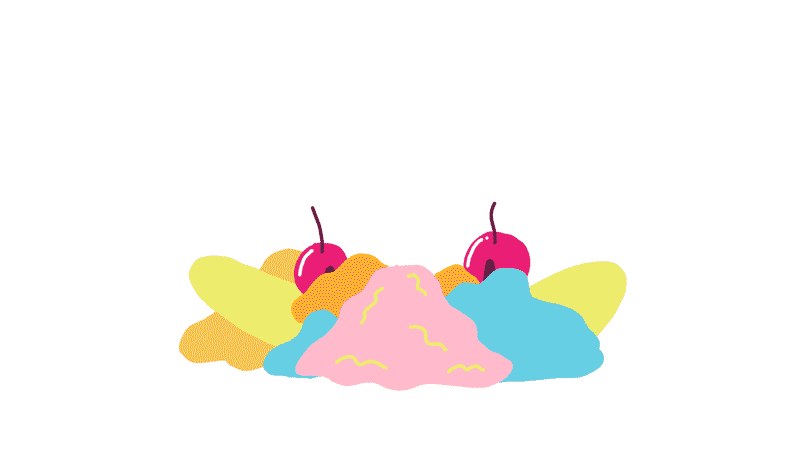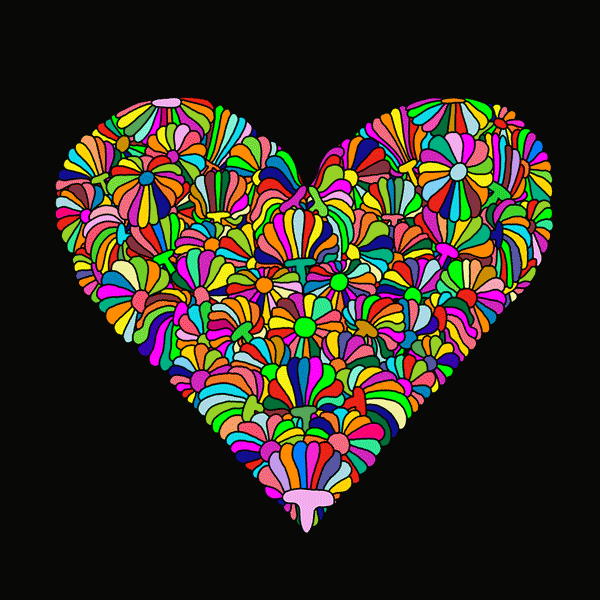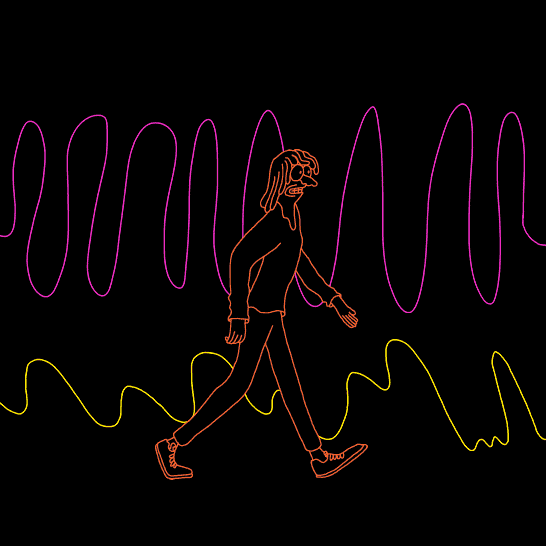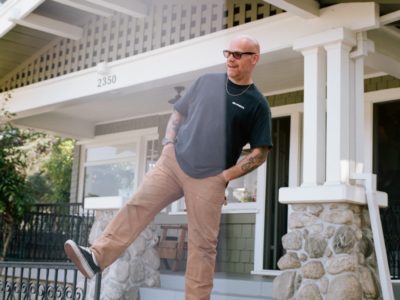Mike Perry, Artist + Animator
WORDS BY | LEAD PHOTO BY: EMILIANO GRANADO

Besides making the ever-changing titles you see on Broad City, Mike Perry is an illustrator, creative director, brand consultant, poet, and designer—if you need a lesson in multitasking, this is your guy.
Meet Mike Perry
INTERVIEW BY: ARIELA KOZIN
In the days of social media, if you have Photoshop and a smartphone, you can call yourself an artist. There is an overflow of aspiring professional creatives hoping to cash in on their craft, so in order to stand out, you have to be the best of the best. We’re not talking about only perfecting your painting skills, but also being able to transform those paintings for the digital world to turn your name and your aesthetic into a brand.
There are few artists who can straddle the line between mainstream pop culture while remaining respectable in the art world. One of the few success stories belongs to a man named Mike Perry. After studying graphic design in Minneapolis, Mike got a job designing for the retail giant that is Urban Outfitters and it all built from there.
Comedy Central tapped him to make an opening title for a new show about two 20-something women navigating New York called Broad City. While Ilana Glazer and Abbi Jacobson went from underground fixtures to household names, they brought Mike’s creativity along with them to make thirty different animations for the show’s intro. The Brooklyn transplant has become known to millions—and yes, that’s how we found him too—because of his bold, explosive animations each week. And guess what? He’s working on Season 4’s intros as we type.
But alas, there was a Mike Perry before, during, and after his work with the Comedy Central hit series. He’s also published 11 books, has created works of art for major international brands like Nike and GQ, and is Tidal Magazine’s creative director among his “30 other” projects in development.
If we could pinpoint one reason why Mike has been able to turn art into a phenomenal career, it’s that he’s never done challenging himself. He mastered brand design, so he went into animation, and then poetry, and then typography, and so on and so on. He’s always ready to go beyond expectations.
From the outside looking in, how would you describe Mike Perry?
Colorful. I do think that my instinct to say “colorful” is pretty spot on. I made the conscious decision early in my career to change my name from Michael to Mike as a decision to be more casual just to always try to maintain the youthful quality of the life that I really want to live. I try really hard to just be that person and present that thing to the world, so I really hope that people see a sense of playfulness and curiosity and self-exploration, but also just participating in the universals that make us human.
It seems like your art really encourages people to escape inside themselves in their imagination—would you agree with that?
Yeah, absolutely! And I think sometimes people need a little bit of a starter image or an opportunity to just understand that you can go down that kind of visual path in your own personality and self-exploration. So if I can share my discoveries with the world, then I’m doing my part.
You’ve been really involved in creating a community with your art or name at the center, whereas many other artists tend to be more reserved. So why do you think community and the arts are so important to one another?
In a selfish way, I spend a lot of time alone so it’s nice to hang out with other people. One of the things that is a reality of being somebody who has the desire and ability to go pretty deep into a single exploratory existence—in order to do that, you need to carve out some serious alone time, I think personally. A lot of artists do stay reserved and insular, but I think for myself, I studied graphic design, I’ve worked in the world of business and collaboration is a really essential key to that. There’s also, in my own studio structure, as I’ve grown, the first person I hired to work in the studio was not someone who could view what I do and help me to alleviate some of the work that I was doing, but instead someone who does something completely different than me so that I can learn a new skill and I can grow my practice and my ideas—community often presents that opportunity. When you are willing to be excited about what someone else is doing and engage with them on a pure level, you yourself have an opportunity to learn and grow your own knowledge and expertise. But in reality, I just love people and I see the power of community.
When you are willing to be excited about what someone else is doing and engage with them on a pure level, you yourself have an opportunity to learn and grow your own knowledge and expertise.
When is New York most inspiring to you?
I’m from Kansas, and growing up there was all of these Leave it to Beaver myths about rural communities having these true small-town vibes, but in reality it was just lots of people in cars driving places and shopping malls and all that stuff. And when I moved to New York I started to walk everywhere and I live a 10 minute walk from where I work and the act of walking slowly engages me with actual human beings, and then all of the sudden you start to see the city and systems and the way they work in really benefitting the community. I live in a Caribbean neighborhood and I have slowly noticed that the culture of this neighborhood has seeped its way into my subconscious and then ultimately into the visual language that I use. I consider myself a round being that’s trying to not just plan the drawings, but let the drawings come out and let them be informed simply by my existence.
We first discovered you through Broad City. How were you first hired for the role?
I made animated GIFs as a young computer user tends to do, so I understood the concept of how they work. I definitely did not really know what it meant to do an animation or how it worked. I didn’t even understand how many frames there were per second, honestly. I didn’t really know what it meant to have a client in my career until I started working with Comedy Central. From the beginning, I basically pitched a dozen concepts and direction and immediately they were just very supportive and excited. Chris Scarlotta, one of the creative directors, was like, ‘ just go for it!’
My process is usually to try to generate as many ideas as possible, almost just try to vomit them out because fortunately I have them and they just come out and pour out. The job was to do one single title graphic for the show that would be in every episode for the entire season. So I rolled in with so many ideas and they were so pumped that they didn’t really want to choose, which is how we came up with doing a new concept for every episode. It was just this phenomenal moment where I, as a hungry youngster, created job security for myself on accident. It could have been this one simple job, but it became this whole existence where my entire being was wrapped into it. I’m working on it all the time which is amazing and I love it. Without having any experience or any animation work in the book to show, they were like, ‘We believe you and we trust you. And if you have any questions, concerns, or things you want to talk through that you don’t know about the process, just ask.’ Phenomenal right? Like nobody does that.
Besides Comedy Central, Abbi and Ilana are running the ship. They don’t even want me to know what the episodes are about because they just want me to do me. I’ve decided that I’m like a satellite—like, the show has this whole production, and I’m this satellite to the side that has this connection but doesn’t see anybody and doesn’t talk to anybody, but if it needs to connect it does. And that allows me this kind of space. And ultimately, that privilege and that safety net is how the work gets to be so important and weird.
So this is the dream job?
Oh yeah! I mean, it’s ridiculous! As far as moving forward, and being pulled in different directions and all that…I’ve chosen to put myself in this position where I’m presented with lots of different path ways because it’s what I want—that’s what I’m interested in. I never bought into the whole theory that if you’re an artist you have to focus it and have a thing that you do, that feels too limiting. I’d rather just be focused on what the ideas are and where the journey takes us than making the same thing over and over again. So that’s exciting and it does lead to fascinating opportunities. I’m a fortunate human being.
I never bought into the whole theory that if you’re an artist you have to focus it and have a thing that you do, that feels too limiting. I’d rather just be focused on what the ideas are and where the journey takes us than making the same thing over and over again.
What other projects are you working on?
I am doing 30 other things. I’m working on something pretty exciting that I can’t talk about, which is always good. Today, I’m working on the Broad City title, I’m working on season 4 right now. I have some art show stuff coming up. I’m trying to learn more about storytelling and continuing to try to write things. I’m lucky to be able to just come in and figure it out everyday.
I’m speaking at some conference in June. They sent the contract yesterday and there’s all of these lines about no cursing so I’m trying to get them on a call because I’m like, ‘I don’t know if I’m capable of fucking doing that.’ I’ve got all this stuff but it’s not coming out until fall so I’m in production mode right now.
What do you think separates successful artists–who can make a living off their art–from everyone else?
That’s a complex question. Ultimately, there’s an infinite number of factors that lead towards everyone’s place in the world. If you inherently come to the game with a pile of cash and some fancy connections, the success financially of being an artist is a different game. Versus if you come with the opposite which is, you show up alone and you knock on some doors and hope someone answers—that’s a harder game. For myself, I definitely came from the middle. I went to art school, I got a really great job after school that came from a relationship that I had in Minneapolis, and that lead me to work at a company that I dreamed of working for and then I met my wife there and she lived in New York, so when I moved to New York I had someone there to help me get my feet off the ground and all that stuff. All I can do is work hard and try to do my best. One of the things that’s nice about having a team is that it takes the selfishness out of it. The success of me running the studio is not just about me and my livelihood, it’s about keeping the lights on for everybody that works here, and that makes me understand and value what it means to work really hard—so that we can keep the machine running. I’ve said this before in interviews, but I believe that the studio is a spaceship and it takes a team of people to keep it running and we always need fuel, that’s the money.
Broad City will return with all new episodes (and all new titles via Mike) in August this year.
For more on Mike Perry, check out his site and follow him on Instagram + Twitter.



















